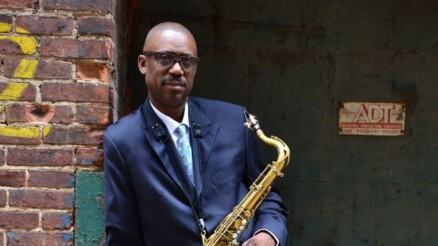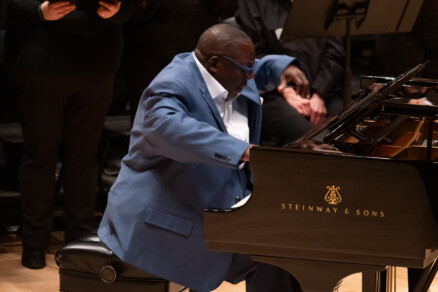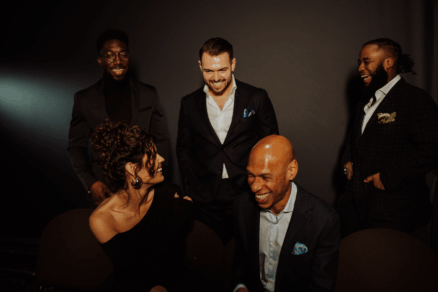Tarus Mateen’s never-ending journey
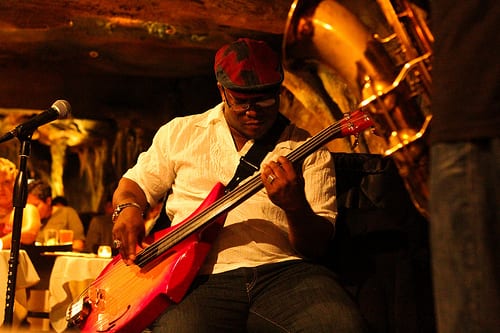
Editor’s note (Jan. 27, 2015): Tarus Mateen performs this Wednesday at the Kennedy Center’s Millennium Stage. Info is available here. We are reposting this 2012 profile in advance of that gig.
It’s a little before 11 p.m. on a Tuesday, and Bohemian Caverns is just about half full. A dingy darkness hangs about the basement club, but Tarus Mateen – seated on a stool onstage, with a hollow-body electric bass lolling in his lap – is glowing. He’s close to the end of the show, the first of five Tuesday-night performances he’ll give this month as part of a month-long residency at the Caverns. You can tell he isn’t ready to wrap things up. In between songs, Mateen, 44, shares a story of childhood jam sessions, rhapsodizes about the power of music, and extends an invitation – an ultimatum, really – to audience members: dive in with him, and get immersed in the music.
Mateen has just finished playing another one of his compositions, which are dominating the show this evening. Most of them are trenchantly grooving things, with harmonic structures extracted from West Africa and points east. Over the years, he has recorded them with some of the top names in jazz, but Mateen hardly ever leads his own band, so his originals rarely find their way to the stage.
Which is not to say he is short of work. On the D.C. jazz scene, Mateen is ubiquitous: On a given weekend, you might find him playing an experimental set on Friday night with saxophonist Brian Settles, soul-jazz at trumpeter Donvonte McCoy’s regular Eighteenth Street Lounge gig on Saturday evening, and a straight-ahead brunch gig with saxophonist Marshall Keys on Sunday. Thanks to a giddy blend of malleability and autonomy, Mateen is the definitive force in almost every band he joins.
If someone tells you Tarus Mateen isn’t the most important bass player living in D.C., it’s likely that they either haven’t heard him perform or they prefer bassists to remain submerged in a group’s aesthetic, serving as a pedestal rather than a principal. His most famous work is with the New York-based pianist Jason Moran’s trio. During an interview with DownBeat, conducted after the group’s latest record won Album of the Year in the magazine’s 2011 critics’ poll, Moran spoke about Mateen’s strong pull in the trio. “Tarus is the major protagonist who pushes the music, and we work at intersecting with each other to have conversations,” Moran said.
On a charbroiled afternoon in late June, Mateen sits down with me for an interview in the study of his home, in the central, tree-lined neighborhood of Bloomingdale. He’s wide open about his life and music, and his high voice often crescendoes into a cackle – especially when discussing the constant search for inspiration that is improvised music. Intermittently, he flashes a powerful smile, wise and honest. Mateen’s thick haunches straddle an office chair, which he swivels slowly as he talks.
He tells me that his musical code revolves around “intently listening” to his partners, but zealously making his own innovations heard. “To move forward is a testament to how much you do believe in what you’re doing, and how much you trust the people that you’re doing it with,” he says.
***
Tarus Mateen was born on Oct. 21, 1967, and grew up in the central Californian city of Bakersfield. His family was active in the Nation of Islam, staying with the organization in the 1970s as it shifted away from isolationism and toward an embrace of orthodox Sunni Islam.
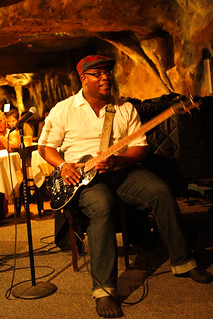
Mateen acquired an abiding love for music early on, and he remembers formative 12-hour jam sessions in the family garage with his older brothers: Umar on drums and Radji on saxophone. “Those days in the garage, the air was like a swamp,” he says. “We had to take the water hose and wet the filter so that the cold water would make the air cool. The water would come through and hit you, and you’re getting shocked trying to sing” into the microphone. “Just shedding, shedding, shedding, all day. Me and my brother going duo, all kinds of styles, whatever.”
As artistically and socially conscious Black men growing up in the 1980s, Mateen and his brothers developed a special relationship with dub reggae. “We used to travel to Jamaica and do family vacations. And that’s where we got introduced to actually knowing how to really play dub reggae, and a lot of ’80s stars,” he recalls. “Next door to where we used to rent was the house where all the people would go to buy their cocaine and weed, all that kind of stuff.” That house, understandably, was a stomping ground for some of the country’s most important musicians: “Freddie McGregor, Judy Mowatt, Black Diamond. I was … watching those musicians just practicing.”
The Mateens befriended the man who owned the house and ran the drug distribution business – then they became his family. “It’s just crazy: My mother ended up remarrying, and married that guy. He did time, did like nine years. You know, he was the big drug guy in Montego Bay,” Mateen says. There were certain perks. He was so well connected in the musical world that he was able to help the brothers join the Jamaican musicians union in 1979, when Tarus was only 11, and they began performing with McGregor and Mowatt, major stars both on the island and internationally.
Mateen graduated from high school in 1985 and moved to Atlanta to attend Morehouse College. He was largely self-taught on the bass, so he never learned to read music fluently (he still doesn’t). But playing in Atlanta clubs, he quickly learned that with his adept ear he could keep up in a jazz jam as well as on a reggae bandstand.
After a year of college, Mateen dropped out and moved to the city’s West End neighborhood, joining a community of Muslim activists led by Jamil Abdullah Al-Amin, the former Student Non-Violent Coordinating Committee leader who had been known as H. Rap Brown. Simultaneously, he continued to soak himself in Atlanta’s rich Black music community.
“When I first moved to Atlanta, in ’85, my first experience with a jazz master was playing with Eddie ‘Cleanhead’ Vinson. I was 17, in some club,” he says. Vinson was playing alto saxophone, sitting on a “tall barstool, with his leg crossed, burnin’. That was a very big learning period for me.… I started learning from all these musicians who had lived in New York and then moved back to Atlanta.”
Three years later, while on a gig at the Savannah Jazz Festival, Mateen came in contact with one of the most influential and catalytic musicians in jazz history, Art Blakey, the legendary drummer and fellow Muslim whose mission in life seemed to be to kick-start other great careers. “We hung out, talked, kicked it for real. He told me his whole life story that morning,” Mateen recalls. Blakey encouraged Mateen to head to New York, and the rest of Blakey’s young band got behind him. A few weeks later, Mateen went to New York for a brief stay, sitting in with Blakey every night at Sweet Basil, where the drummer was doing a two-week run.
He retreated to Atlanta for a few weeks, where he was living with a wife and young child, but New York beckoned him back. He soon returned, this time to stay, and began to accrue a reputation. The vocalist Betty Carter had heard him play at a jam session, so she brought him to Fat Tuesdays, the club where she was performing, for an onstage audition. He passed, and at the start of 1989 he joined her touring ensemble. Mateen began to work regularly with other musicians based in New York – many stationed in Harlem – including Marc Cary, Rodney Kendrick, and a number of legendary personas from Carter’s generation, notably Arthur Taylor and Walter Davis, Jr.
“There were still so many people around at that time, so that whole energy inside the music was still thrashing,” he says, reminiscing on the generation of musicians who had lived through what’s often called the golden age of small group jazz. “You’d never know who was in the audience or who would walk in, so you always had to have your thing together.”
***
After two years in New York, Mateen moved back to Atlanta in 1991, but he maintained a rigorous touring schedule as a member of trumpeter Terence Blanchard’s band, among others. His return also came during a heady time for Atlanta’s music scene, perhaps its most important moment in decades: The city was becoming the epicenter of the incipient Southern hip-hop movement, which for the next 15 years would stretch out and beef up the powder-keg urban sound that had been born in the Bronx. Live bands were a central component of the South’s new, autonomous subgenre; this represented a major revamp for a music that had hitherto revolved around DJs and sampling.
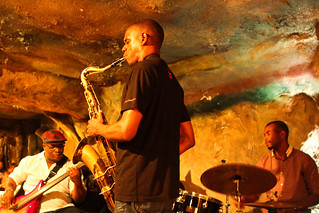
At that point, Mateen and his brothers were all based in Atlanta, where they had a band that played dub and funk, often collaborating with spoken-word poets around the city. Word of his playing seeped into the hip-hop world, and he began to work with an array of bands, mostly through the production team Organized Noize. In one whirlwind night at the studio, Mateen recorded bass lines for “Benz or Beamer” by Outkast, “Cell Therapy” by Goodie Mob, and a remix of TLC’s smash hit “Waterfalls.”
Eventually, though, New York found a way to beckon him back. In spring of 1998, Mateen recalls, “I went to play a concert [in New York] for the Goodie Mob album Still Standing’s release party. And everybody was there – Puffy was there, Andre 3000 was there, I think Snoop was there – because we had the baddest band of that period.”
In 1993, Mateen had gone on a spiritual quest to Senegal, where he converted to Sufism, a more introspective and metaphysical form of Islam. But back in Atlanta, he’d lost track of some guiding principles. “I had been living real hard, in terms of the party life and all that. But at the same time, I’m part of a Sufi brotherhood that deals with discipline and purification,” he says. On the New York trip in 1998, he met up with an old friend, who was originally from East New York but had studied Islam in Senegal. “When he saw me, he was like, ‘You cannot go back to Atlanta. You’re staying in New York.’ So he made me stay,” Mateen recalls. “That’s when I moved up to 113th Street, and I stayed with him. Between him and Marc Cary, at 155th.”
Mateen spent the next five years chin-deep in the New York jazz world, and he was prodigiously productive. He toured and recorded albums with Cary, the saxophonist Greg Osby, the vibraphonist Stefon Harris and – most importantly – Moran.
***
Directional metaphors are prominent in progressive jazz. On a couple of Miles Davis’ early electric albums from the late 1960s and early ’70s, he crowned his album covers with the inscription “Directions in Music by Miles Davis.” A supergroup in the 1990s that included Herbie Hancock, Michael Brecker and Roy Hargrove picked up on the phrase, calling its album “Directions in Music.” Osby assembled a sextet with five promising younger musicians in 1998, and he called that band New Directions (which also happens to be the name of an expansive Jack DeJohnette album, from two decades prior). Mateen, Moran and the drummer Nasheet Waits comprised New Directions’ rhythm section.
The principal implication of all this talk about vectors and paths is that jazz ultimately points forward, that it reminds us how much lies beyond the haze of music we’ve already discerned. But if there’s a direction that most concerns Mateen, Moran and Waits, it’s inward. They’re a trio of keen listeners and tonally sensitive improvisers, who refract every lesson they’ve accrued – from hip-hop, jazz, global classical musics, literature, spirituality and everything else – through delicate reflection.
And yet, they pummel – and they pitch themselves onward. The three proved too mercurial and self-directed a rhythm section for Osby to keep around, and eventually the New Directions group disbanded. But Moran, recently signed to Blue Note Records, had been looking for a rhythm section to record his sophomore record – and on the New Directions tour, he found it.
“There’s a brimming rawness at play every time they perform, and a kind of devil-may-care attitude, in that they will do whatever is necessary” to express themselves, Osby tells me. “And Jason is not a dictator; he’s not a musical demagogue in terms of direction – so he gives them enough rope to move freely.”
Waits adds: “The intent that you have to approach the music with is really intense, and thoughtful. And both Jason and Tarus – they personify that, all the time.” He describes the trio’s music as “almost like infinite resolution…. There’s an ongoing momentum.”
The trio started to perform together immediately, and although it was usually billed as the Jason Moran Trio, its members began referring to it as the Bandwagon. In 2000, Moran released Facing Left, a trio album and the first of six with the Bandwagon at its core. On this record, you can hear the group starting to extrapolate on ideas about what hip-hop’s rhythmic feel can mean; not only were Moran and Waits mimicking the flow of its great emcees (the former mostly with his right-hand phrasing, which often funnels into hammered single-note patterns reminiscent of a rapper’s flow, and the latter with his snare/hi-hat interplay, which can be redolent of both rapping and the boom-bap of a DJ’s sample). They were also adding an Ellingtonian, orchestral representation of the chaos, soot and ruffled tranquility of metropolitan life, all updated and cooked down for today.
Fast-forward five and a half years, and the Bandwagon – now well-known not only for its concerts and recordings, but also for getting frequent commissions from museums and performing arts centers – was at Jazz at Lincoln Center to perform “RAIN.” This performance gives a similar update to the ring shouts of African-American slaves, adding a full suite of instrumental catharsis to an age-old art form based on stomps, shouts and clapping.
Moran is adept at using the whole range of the keyboard, and Mateen might often jet all the way up the neck of his bass in a writhing, clacking leap. Tenacious and broad-shouldered, Waits sometimes seems to be hitting every single drum in the kit, all at once. Each player’s palette is critical to the trio’s pursuit of total immersion, a form of expression built upon both vigorous introspection and wide peripheral vision.
***
In 2005, the highway came calling for Mateen again, and he left New York for good. He moved to Philadelphia, where he became active on the local scene, and then moved to D.C. He still tours with the Bandwagon and performs occasionally in New York, but spends most of his time in the District, playing multiple nights each week at local clubs. He doesn’t have any plans to make an album of his own in the near future, despite having recorded an overflowing handful of original tunes with other people’s bands, and having established himself as one of the most distinctive bass stylists in jazz.
So the way to appreciate his work as a leader is onstage, in its natural environment. This month, the place to do that is at Bohemian Caverns.
The club’s artist-in-residence program spotlights a different D.C. musician every month. Omrao Brown, the club’s owner, originally conceived of it as a forum to help artists build a rapport within a particular group. “The idea was to provide a regular run for a band, allowing them to work on their book,” Brown told me via email last year, soon after he launched the program. That way, a band could hone “a specific set of tunes for a recording. Not quite a paid rehearsal, but definitely a working weekly gig.”
But Mateen is just beginning to feel his way forward as a band leader, and he’s never been well suited to a stationary mode. So he is using each of this month’s five Tuesdays to surround himself with a different small ensemble.
That first week, he performed in a stark trio, with Settles and the young drummer Terence Arnett. The R&B singer Brittany Tanner, whose debut album Mateen is currently producing, sat in for a pair of tunes; during one of them, Settles was hardly present, Arnett held down a simple pattern, and Tanner strained whenever she wandered above or below the meatiest parts of her vocal range. Fending mostly for himself, Mateen built groove; thick, rattling harmonies; and trilling solo runs that filled the neat crevices his chords left for them.
The following week, Mateen brought in the pianist Federico Peña to fill out the band. At tonight’s show, Mateen will perform with Peña and drummer Sean Rickman, who toured last year with Herbie Hancock, Wayne Shorter and Marcus Miller. He’ll also welcome his cousin, Khari Mateen, a cellist and vocalist.
No matter whom he’s playing with, Mateen always holds one lesson paramount, inherited from the older musicians and Sufi spiritual guides he has followed. “When you’re presenting, always be on the highest level that you can,” he says. “Every second, we go further away from the reality of this physical life, and we get closer to the reality of our next life. That’s the forwardness that I’m talking about.”
—
Tarus Mateen performs at Bohemian Caverns tonight, and both of the remaining Tuesdays in July. More information is available here. Tickets are $10, and can be purchased here.
Bohemian Caverns, Brian Settles, DC, Greg Osby, Jason Moran, jazz, Nasheet Waits, Omrao Brown, Tarus Mateen, U Street, Washington


